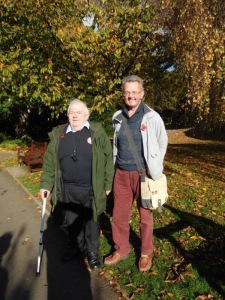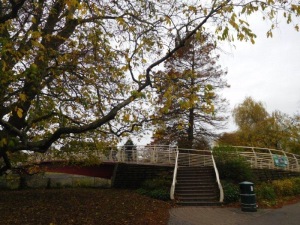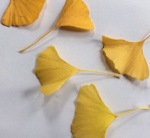What immediately comes to mind when you attempt to distinguish Cardiff as a city? Maybe its’ Victorian shopping arcades, bay and barrage, resplendent castle (currently adorned with a hideous Christmas tree) hallowed rugby ground or renowned civic centre? The fact that it has the largest collection of trees – or Arboretum – in a municipal park in the UK is not at the forefront – yet it should be . Cardiff is a true tree mecca for trees and Bute park’s tree collection – although not comparable to the enormity of Westonbirt arboretum in England is certainly worth visiting for its superb variety. Why aren’t Cardiff Council tweeting it from the treetops?
The tower blocks of Nature that are our trees in Cardiff parks are in part thanks to the building work (or rather planting work) of two men who led the recent walk in Bute Park as part of National Tree Week founded in 1975 by the Tree Council – http://www.treecouncil.org.uk. Malcolm Frazer and Terry Davies are welcoming and inspirational and keen to share their deep knowledge of trees and shrubs with anyone who is prepared to listen – often indulging in a bit of playful banter that would make Laurel and Hardy proud.
As a complete tree novice I am embarrassed to admit that I often won’t recognise the most common British trees which surround our daily travels on foot through our parks or by car along our city streets. (By the way – Terry informs us – Did you know that Cardiff has quite a reputation for experimenting with roadside tree planting? )
Terry And Malcolm hope that by explaining the importance of our trees they will lay new foundations to them being treasured and replenished so their lifelong work will continue for the next generations. In these times of council budget cuts, traffic congestion, air pollution and fast-paced city life it is vital that we preserve our green spaces. The trees and parks offer us true mindfulness and deserve nurture and respect. I have recently come across this Greek proverb – A society grows great when old men plant trees whose shade they know they shall never sit in’ which makes you think. We all need to take responsibility and contribute to the continuation of planting for the future by supporting local ‘ friends’ groups such as the Friends of Bute Park – https://friendsofbutepark.com and Roath Park – http://friendsofroathpark.weebly.com. to name just a couple. The knowledge is there if you look for it and no more so than amongst the pages of the fantastic web resource continually enhanced and developed by Anne and Andy Bell – Cardiffparks.org.uk
Terry and Malcolm’s genuine enthusiasm is catching and once you have been on one of their walks you will want to join them every time.This Spring and Autumn their walks focused on Roath Park and the bright sunny Autumn brought a huge crowd. Narional Tree Week is a bit more wintry but the Autumn colours still remain and some of the UK and Welsh champions they have planted still look magnificent.

The journey begins as we cross the Millenium Bridge into the park. Either side, like two sentries is the the Swamp Cypress(Taxodium Distichum) on the right and the Caucasian Wingnut (Pterocarya) on the left. The Wingnut is from the Walnut family but Terry explains that unlike the walnut, the wood of the Wingnut is too light for joinery. Tended by Terry, this particular one, although a good size, is less than 60 years old. He explains that its’ girth will continue to increase year on year but it has reached its’ maximum height.



The grouped plantings of trees are impressive in the park – there are apple trees with tiny red crab apples still in fruit, a line of curvy-trunked magnolias and an array beautifully coloured rowans.
Trees have much history and myths attached to them and we look up in awe at the shimmering golden Gingko with its perfect fan like leaves clinging on proudly. Famed for their wellbeing properties, Terry explains that the Gingko tree’s make-up is a complicated chemical one – so much so even insects tend to give its’ leaves a wide berth!

Originating in China, Gingko is revered in Asia and is planted around the temples of Japan. In Cardiff both male and female Gingkos thrive. They attract foragers who scoop up their leaves to infuse and drink as tea or gather their fallen berries to use in stir fries or soups. It has long been used in traditional Chinese medicine. A Chinese lady I met in Roathmill gardens explained how this year has been particularly good for the Gingko nuts ( the berries) . She believed in their health enhancing properties but warned me to check on the internet before I consider adding them to my diet as consuming too many can poison you!
There is a fantastic range of trees from all around the world in Cardiff – and here in Bute Park we are shown the Chinese ‘handkerchief’ tree (latin – Davidia involucrata) I love its’ name which aptly describes the hanging papery leaves in Spring. It has yellow balls of fruit on it now. We are told that there are four of these trees in Bute Park and two in Roath Park. There is a memorial stone in front of this one and it reads – ‘given by American born Chinese to British born Chinese’ which reflects the diversity of Cardiff.


As we pass a variegated Holly – an ilex aquifolium – Malcolm points out two holly tree ‘champions’ and explains that in pagan times holly (together with yew and ivy) represented Life in the darkness of Winter. Holly wreaths would ward off evil spirits.
I am getting to recognise some of the Latin names – at least the first word of a tree’s name as it is the name of the group to which it belongs. A holly’s name always starts with the word ‘ilex’ There are so many varieties and Malcolm points out lovely variegated leaves.

More on that next time……

